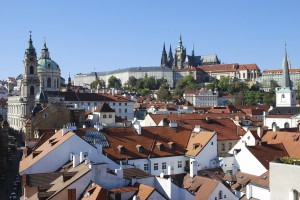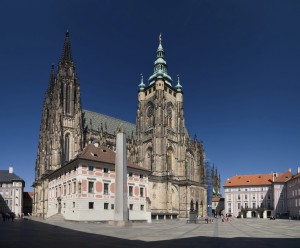Prague Castle
By Erin Naillon
Introduction
Prague Castle is the largest castle complex in the world. This stunning architectural achievement, which took centuries to complete, reigns supreme from a hill above the rest of the city. It is also the seat of the city of Prague; the first buildings of the small settlement that grew into the capital of Bohemia were constructed here.
 Early History of Prague Castle
Early History of Prague Castle
Prague Castle, it is believed, was founded by Prince Bořivoj, one of the members of the Přemyslid dynasty that ruled the Kingdom of Bohemia for centuries. Bořivoj founded the castle circa 880; the site was highly advantageous, being near water (the Vltava River) and on a hill, allowing the inhabitants to see the enemy approaching from some distance. Being, from the beginning, a fortress, Prague Castle had a moat protecting it, as well as a thick wall. The small scattering of buildings gradually grew and grew together. It was the administrative seat of the kingdom and the residence of the Archbishop of Prague, and the buildings reflected this importance.
 First Religious Structures
First Religious Structures
Prague Castle is the site of the first convent ever built in Bohemia; this Benedictine convent is located next to St. George’s Church. Perhaps the most impressive building in the complex is St. Vitus’ Cathedral, which took a staggering 1,000 years to build. The Cathedral holds the remains of royalty and Saints Vitus and Adalbert, along with Wenceslas I, patron saint of Bohemia. It also serves as a showcase for the impressive silver tomb of Saint John of Nepomuk, who was tortured in another building of the Castle.
Charles IV
In the 14th century, during the reign of the King of Bohemia and Holy Roman Emperor, Prague Castle was the seat of the Holy Roman Empire. As befitted this high-ranking and popular sovereign, the royal residence was rebuilt. Wenceslas IV, son of Charles IV, continued construction work on the complex, as did his descendants, favoring the Castle with buildings of various architectural styles.
Rudolf II
During the 16th century, the dandified Emperor Rudolph II of the Habsburg Empire worked the magic of his own on Prague Castle. Rudolph, intensely interested in science (including alchemy), magic, and art, created the north wing of the Castle, the Spanish Hall, as a repository for his artworks. Not long after Rudolph’s demise, Prague Castle underwent siege and plundering; royalty no longer lived there, and the complex became dilapidated.
Foundation of Czechoslovakia in 1918
Prague Castle received a new lease on life in 1918 when the independent Czechoslovak state was formed. The first president of the new country, Thomas Masaryk, used it as his base, and heads of state once more used the Castle as a residence. What may have been the darkest era for Prague Castle occurred during World War II, when none other than Adolf Hitler came to visit this jewel in the crown of the “Reichsprotektorat” of Bohemia and Moravia. A photo shows Hitler leaning out of a window in the Castle, looking at the city below.
Vaclav Havel
When Communism fell and Václav Havel was elected President of Czechoslovakia, this dissident playwright, who had spent more than a little time in prison cells during the totalitarian era, became the newest resident of Prague Castle. With a theatrical flair, he had the castle guards’ uniforms redesigned by the costume designer of the film Amadeus, which was shot in Prague.
Those interested in the history of the area can visit the permanent exhibit titled “The Story of Prague Castle”. The exhibit traces the very beginnings of the Castle up to the 20th century, with exhibits of various archaeological finds (including some skeletons and grave clothing).




